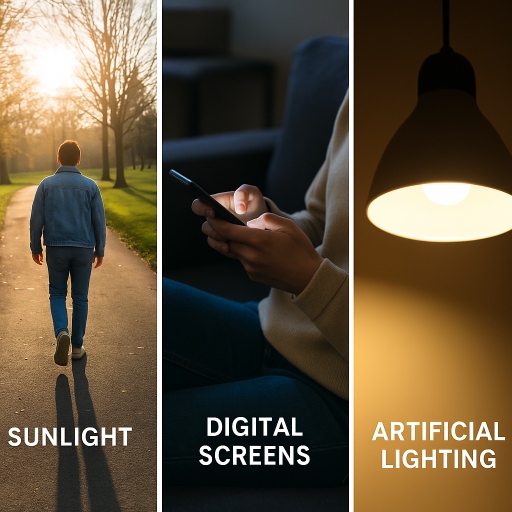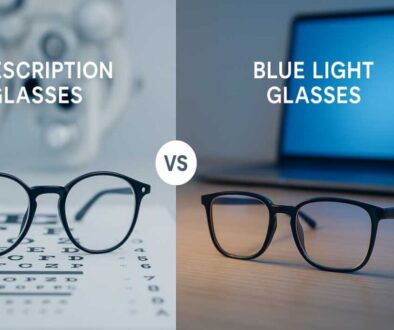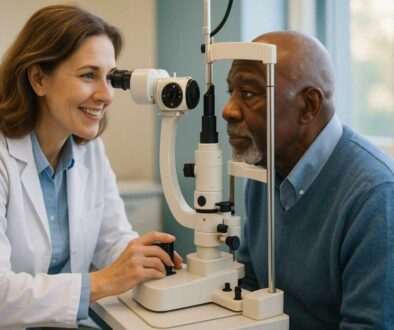Blue Light Explained: Health Risks & Prevention Tips
What is Blue Light?
Blue light is part of the visible light spectrum – the range of wavelengths our eyes can see. Red light has lower energy, while blue light carries higher energy.
Sunlight, bathing Fort Collins just like everywhere else, contains a mix of colors, including significant blue light.
This high-energy visible (HEV) light also comes from everyday sources:
-
The Sun (The primary source by far)
-
Digital Screens (Computers, Smartphones, Tablets, TVs)
-
Artificial Lighting (LED, Fluorescent, CFL bulbs)
Sunlight vs. Screens: Which Blue Light Source Poses Greater Risk?
Not all blue light exposure carries equal risk. Understanding key differences helps Fort Collins residents make smarter choices for eye health and sleep quality.
Comparing Blue Light Sources:
-
Sunlight:
-
Intensity: Very High
-
Exposure Pattern: Natural, intermittent bursts
-
Risk Level: Generally Lower
-
Why? Provides balanced full-spectrum light that reinforces natural circadian rhythms. Essential for daytime alertness in Northern Colorado lifestyles.
-
-
Digital Screens (Phones, Tablets, Computers):
-
Intensity: Moderate
-
Exposure Pattern: Prolonged close-range use
-
Risk Level: Higher Indoors/Evening
-
Why? Extended proximity causes eye strain while evening exposure disrupts melatonin – especially concerning for Fort Collins students and remote workers.
-
-
Artificial Lighting (LED/Fluorescent):
-
Intensity: Variable
-
Exposure Pattern: Extended indoor exposure
-
Risk Level: Moderate Nighttime Risk
-
Why? Blue-rich bulbs used after dark can mimic daylight, confusing your internal clock.
-
Practical Guidance for Northern Colorado Residents:
-
Harness Morning Sunlight: Take morning walks outdoors to naturally regulate your sleep-wake cycle – easy with Fort Collins’ 300+ sunny days!
-
Create Screen Curfews: Reduce digital device use 1-2 hours before bedtime
-
Install Warm Lighting: Use amber-hued bulbs in bedrooms and living areas after sunset
-
Position Screens Wisely: Keep devices at arm’s length (18-24 inches) during daytime use
How Does Blue Light Affect Your Body?
Blue light interacts with your body in several key ways. Moderated exposure offers benefits, but excessive amounts – common in modern life – pose risks, especially for eye health in Fort Collins families.
The Benefits: Natural Regulation
-
Boosts Alertness & Mood: Morning sunlight (rich in blue light) signals your brain to suppress melatonin, the sleep hormone, helping you feel awake and focused.
-
Regulates Sleep-Wake Cycle: This natural suppression is crucial for maintaining a healthy circadian rhythm, aligning your energy with daytime hours.
The Risks: Excessive Exposure
Too much blue light, especially from close-range screens after dark, disrupts this balance and may contribute to:
-
Persistent Eye Strain: Digital eye strain (common in Fort Collins office workers & students) causes dry eyes, irritation, blurry vision, and headaches from prolonged screen use.
-
Sleep Disruption: Evening blue light exposure tricks the brain into delaying melatonin production, making it harder to fall asleep and reducing sleep quality.
-
Potential Long-Term Eye Health Concerns: While research is ongoing, optometrists monitor possible links between cumulative HEV exposure and conditions like:
-
Age-related macular Degeneration (AMD): A leading cause of vision loss involving deterioration of the central retina (macula).
-
Retinal Damage: Theoretical concern exists that chronic high-energy exposure could contribute to retinal cell damage over decades.
How Blue Light Damages Retinal Cells
Blue light (HEV light, 400-500 nm wavelength) penetrates deep into the eye, reaching light-sensitive retinal cells. Its high energy triggers complex molecular damage processes. Understanding these helps Fort Collins residents protect against long-term vision threats like age-related macular degeneration (AMD).
Key Damage Mechanisms Explained:
-
Oxidative Stress: Boosts destructive reactive oxygen species (ROS) that attack retinal cell structures – membranes, proteins, and DNA – leading to dysfunction and death.
-
Mitochondrial Failure: Disrupts energy production in cellular “power plants,” causing programmed death (apoptosis) of vital photoreceptors and retinal pigment epithelial (RPE) cells.
-
Chronic Inflammation: Triggers release of inflammatory signals (e.g., IL-6, IL-8), attracting immune cells that worsen tissue damage over time.
-
Barrier Breakdown: Weakens critical protective proteins (like ZO-1) in the retinal pigment epithelium, compromising its nutrient/waste barrier function.
-
Photochemical Injury: Activates natural light-sensitive compounds in the eye, generating harmful oxidative reactions and cellular stress.
Blue Light & Sleep Disruption: A Common Challenge
While blue light is essential during the day, your body struggles to block it effectively at night. Evening exposure from phones, tablets, computers, and even bright home lighting sends conflicting signals to your brain.
Why This Happens:
-
Melatonin Suppression: Blue light detected by your eyes tells your brain to reduce melatonin production, the hormone essential for feeling sleepy.
-
Confused Circadian Rhythm: This artificial light exposure, especially common during Fort Collins evenings, tricks your internal clock into thinking it’s still daytime.
The Result:
-
Difficulty falling asleep
-
Reduced overall sleep quality
-
Potential contribution to insomnia patterns
Protecting Your Sleep in Fort Collins:
Managing evening blue light is key for restful sleep:
-
Use Device Filters: Enable “Night Shift” or install blue light filter apps on smartphones, tablets, and computers 2-3 hours before bed.
-
Choose Warm Lighting: Replace bright white/blue LED bulbs with warmer, amber/yellow-toned bulbs in bedrooms and living areas.
-
Create a “Digital Sunset”: Power down screens at least an hour before bedtime whenever possible.
FAQs
-
What is blue light and where does it come from?
Blue light is a high-energy visible light found naturally in sunlight and emitted by digital screens, LED bulbs, and fluorescent lighting. It has a short wavelength and high energy.
-
How does blue light affect my eyes?
-
Can blue light disrupt my sleep?
-
Are blue light glasses effective in protecting my eyes?
-
How can I reduce blue light exposure at night?
-
Does blue light affect skin health?
-
Are children more sensitive to blue light?
-
Why does blue light cause eye strain?
-
How much blue light exposure is safe daily?
-
Can blue light exposure increase the risk of eye diseases?
-
What are the symptoms of blue light overexposure?
-
Does sunlight blue light affect us the same as screen blue light?
Dr. Eric Torgerson
Owner at Poudre Valley Eyecare
Dr. Eric Torgerson is the owner of Poudre Valley Eyecare, and has been recognized for his contributions to optometry and his commitment to community health through various roles and accolades within the Northern Colorado Optometric Society and the Colorado Optometric Association.
Why Choose Us?
Our advanced technology and individualized care deliver results for patients of all ages. Our routine exams allow us to spot changes in your vision and allow us to treat those changes early. We have a comprehensive understanding of eye care, which means we can treat a wide range of conditions and chronic diseases. Our in-depth routine exams and customized treatment plans set us apart from the rest.


Please note: None of the above should be considered medical advice. If you’re having any concerns about your vision, please reach out to us immediately or see your primary care provider.






